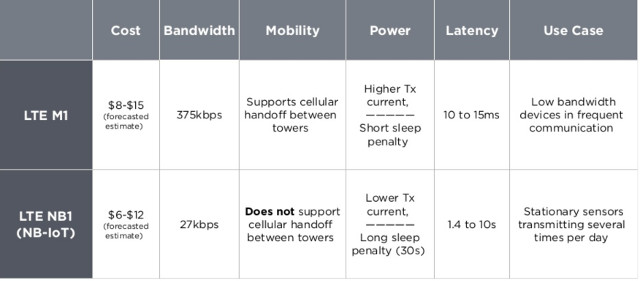Telecom companies also want their share of the IoT business, but with 2G to 4G cellular technology often being too power hungry and/or expensive for this market, 2G on-going – or upcoming – sunset depending on your location, LTE Cat M1 and LTE Cat NB1 (aka NB-IoT) standards have been developed, and used in products like Pycom FiPy board, and SARA-R4 and SARA-M2 modules. If you want to have an overview learn about the new LTE IoT standards and the future of cellular IoT, Particle has published a useful presentation – embedded below – dealing with both, as well as eSIM (Embedded SIM), 2G sunset, and battery life expectations.
 The main takeaways from my reading of the presentation:
The main takeaways from my reading of the presentation:
- LTE NB1 is better suited for low power stationary sensors transmitting a small amount of data a few times a day. Requires new hardware and software
- LTE M1 can be used for actuators and sensors that needs frequent updates. Requires software update to existing base stations.
- eSIM are becoming more and more common, and a “blank eSIM” can be activated anywhere in the world by a local mobile network operator. The many LTE bands across operators and countries however complicates things.
- Consider LTE modules with 3G fallback in markets where LTE is just starting
- The proclaimed 10 to 15 year battery life is mostly hype with a very large battery and one daily update, with real use cases likely to last 12 to 18 months on a battery charge.
If you are interested in the subject, you may want to read through Particle’s 39-page presentation.

Jean-Luc started CNX Software in 2010 as a part-time endeavor, before quitting his job as a software engineering manager, and starting to write daily news, and reviews full time later in 2011.
Support CNX Software! Donate via cryptocurrencies, become a Patron on Patreon, or purchase goods on Amazon or Aliexpress





Why they use different 4G-LTE-Band´s by supported operators/area? I think it makes it more expensive all over the time.
@rebeL Radio bands are controlled by the government of each country. In the US this agency is the FCC. These bands have been passed out for different purposes over the last hundred years. Since every country’s history is different, the bands got passed out differently in each country. Once a band is passed out and people have spent millions building radios for it, it is quite hard to recover it and give it out to another group. Today all of the bands have been passed out and governments are forced to reuse previously passed out bands. The net effect of… Read more »
The outrageously high cost of data over cellular and having to pay dumb never-ending subscription fees makes low-rate infrequent-use data applications untenable. Remember when “M2M” over cellular was the marketing hype of the day? Yeah, that went nowhere – and neither will “IoT” over cellular.
@Jon Smirl: Yes you are right, old history will never end. You explain it very good, thanks.